Aflatoxigenic Aspergillus Modulates Aflatoxin-B1 Levels through an Antioxidative Mechanism
Abstract
:1. Introduction
2. Materials and Methods
2.1. Determination of Antioxidative Degradation of Aflatoxin by Toxigenic and Atoxigenic Flavi
2.1.1. Assignment of Atoxigenic and Toxigenic Isolates
2.1.2. Aflatoxin (AF) Degradation Assay
- 1.
- Gene Expression (AflR and AflD) Response to Antioxidant (Se)
- 2.
- Generation of RNA
- 3.
- Isolation and Quantification of RNA
- 4.
- cDNA Synthesis (Reverse-transcriptase PCR)
- 5.
- Quantitative PCR (Real-time PCR)
- 6.
- Corresponding Aflatoxin Production with Gene Expression
2.2. Fitness Response of Atoxigenic and Toxigenic Isolates under Antioxidant (Se)
2.2.1. Isolates Collection and Preparation of Inoculation Medium
2.2.2. Fungal Fitness Assay under Antioxidant (Se) Treatment
2.3. Data Analysis
3. Results
3.1. Determination of Antioxidative Degradation of Aflatoxin
3.1.1. Degradation of Aflatoxin in Non-Aflatoxin Producers without Antioxidant Treatment
3.1.2. Change in Aflatoxin in Low-Aflatoxin Producers without Antioxidant Treatment
3.1.3. Change in Aflatoxin in High-Aflatoxin Producers without Antioxidant Treatment
3.1.4. Degradation of Aflatoxin in Non-Aflatoxin Producers with Antioxidant (Se) Treatment
3.1.5. Change in Aflatoxin in Low-Aflatoxin Producers with Antioxidant (Se) Treatment
3.1.6. Change in Aflatoxin in High-Aflatoxin Producers with Antioxidant (Se) Treatment
Gene Expression in Aflatoxin Pathway Genes in High Producer Isolates Due to Antioxidant
3.2. Fitness of Isolates Due to Antioxidant Treatment
4. Discussion
4.1. Degradation of Aflatoxin Levels in Flavi through Antioxidative Mechanism
Gene Expression in High Aflatoxin B1/G1 Producer Isolates in Response to Antioxidant (Se)
4.2. Fitness Response of Atoxigenic and Toxigenic Isolates under Antioxidant (Se) Treatment
5. Conclusions
Supplementary Materials
Author Contributions
Funding
Institutional Review Board Statement
Informed Consent Statement
Data Availability Statement
Acknowledgments
Conflicts of Interest
References
- Ndisio, B.; Peter, W.; Victor, K.; Sheila, O.; Boaz, N.; Wachira, P.; Kagot, V.; Okoth, S. Susceptibility of locally cultivated groundnut (Arachis hypogaea) varieties to aflatoxin accumulation in Homa Bay County, Kenya. Afr. J. Microbiol. Res. 2017, 11, 1329–1337. [Google Scholar] [CrossRef] [Green Version]
- Mallikarjunaiah, N.H.; Jayapala, N.; Puttaswamy, H.; Ramachandrappa, N.S. Characterization of non-aflatoxigenic strains of Aspergillus flavus as potential biocontrol agent for the management of aflatoxin contamination in groundnut. Microb. Pathog. 2017, 102, 21–28. [Google Scholar] [CrossRef] [Green Version]
- Kachapulula, P.W.; Akello, J.; Bandyopadhyay, R.; Cotty, P.J. Aspergillus section Flavi community structure in zambia influences aflatoxin contamination of maize and groundnut. Int. J. Food Microbiol. 2017, 261, 49–56. [Google Scholar] [CrossRef]
- Munkvold, G.P.; Arias, S.; Taschl, I.; Gruber-Dorninger, C. Chapter 9: Mycotoxins in corn: Occurrence, impacts, and management. In Corn; AACC International Press: St. Paul, MN, USA, 2019; pp. 235–287. [Google Scholar] [CrossRef]
- Akello, J.; Ortega-Beltran, A.; Katati, B.; Atehnkeng, J.; Augusto, J.; Mwila, C.M.; Mahuku, G.; Chikoye, D.; Bandyopadhyay, R. Prevalence of Aflatoxin- and Fumonisin-Producing Fungi Associated with Cereal Crops Grown in Zimbabwe and Their Associated Risks in a Climate Change Scenario. Foods 2021, 10, 287. [Google Scholar] [CrossRef]
- WHO. Safety Evaluation of Certain Contaminants in Food: Prepared by the Eighty-Third Meeting of the Joint FAO/WHO Expert Committee on Food Additives (JECFA); World Health Organization: Geneva, Switzerland, 2018. [Google Scholar]
- IARC. Agents Classified by the IARC Monographs; International Agency for Research on Cancer, vol. 1–104. 2012. Available online: https://monographs.iarc.who.int/list-of-classifications (accessed on 18 June 2023).
- Rushing, B.R.; Selim, M.I. Aflatoxin B1: A review on metabolism, toxicity, occurrence in food, occupational exposure, and detoxification methods. Food Chem. Toxicol. 2019, 124, 81–100. [Google Scholar] [CrossRef]
- Li, C.; Liu, X.; Wu, J.; Ji, X.; Xu, Q. Research progress in toxicological effects and mechanism of aflatoxin B1 toxin. PeerJ 2022, 10, e13850. [Google Scholar] [CrossRef]
- Mohsenzadeh, M.S.; Hedayati, N.; Riahi-Zanjani, B.; Karmi, G. Immunosuppression following dietary aflatoxin B1 exposure: A review of the existing evidence. Toxin Rev. 2016, 35, 121–127. [Google Scholar] [CrossRef]
- Zhao, Y.; Wang, T.; Li, P.; Chen, J.; Nepovimova, E.; Long, M.; Wu, W.; Kuca, K. Bacillus amyloliquefaciens B10 can alleviate aflatoxin B1-induced kidney oxidative stress and apoptosis in mice. Ecotoxicol. Environ. Saf. 2021, 218, 112286. [Google Scholar] [CrossRef] [PubMed]
- Gallo, A.; Giuberti, G.; Frisvad, J.; Bertuzzi, T.; Nielsen, K. Review on Mycotoxin Issues in Ruminants: Occurrence in Forages, Effects of Mycotoxin Ingestion on Health Status and Animal Performance and Practical Strategies to Counteract Their Negative Effects. Toxins 2015, 7, 3057–3111. [Google Scholar] [CrossRef] [PubMed] [Green Version]
- Abdel-Hamid, A.A.; Firgany, A.E.-D.L. Vitamin E supplementation ameliorates aflatoxin B1-induced nephrotoxicity in rats. Acta Histochem. 2015, 117, 767–779. [Google Scholar] [CrossRef] [PubMed]
- Rotimi, O.A.; Rotimi, S.O.; Duru, C.U.; Ebebeinwe, O.J.; Abiodun, A.O.; Oyeniyi, B.O.; Faduyile, F.A. Acute aflatoxin B1—Induced hepatotoxicity alters gene expression and disrupts lipid and lipoprotein metabolism in rats. Toxicol. Rep. 2017, 4, 408–414. [Google Scholar] [CrossRef]
- Wang, Y.; Liu, F.; Zhou, X.; Liu, M.; Zang, H.; Liu, X.; Shan, A.; Feng, X. Alleviation of Oral Exposure to Aflatoxin B1-Induced Renal Dysfunction, Oxidative Stress, and Cell Apoptosis in Mice Kidney by Curcumin. Antioxidants 2022, 11, 1082. [Google Scholar] [CrossRef]
- Engin, A.B.; Engin, A. DNA damage checkpoint response to aflatoxin B1. Environ. Toxicol. Pharmacol. 2019, 65, 90–96. [Google Scholar] [CrossRef]
- Drott, M.T.; Debenport, T.; Higgins, S.A.; Buckley, D.H.; Milgroom, M.G. Fitness Cost of Aflatoxin Production in Aspergillus flavus When Competing with Soil Microbes Could Maintain Balancing Selection. mBio 2019, 10, e02782-18. [Google Scholar] [CrossRef] [PubMed] [Green Version]
- Drott, M.T.; Lazzaro, B.; Brown, D.; Carbone, I.; Milgroom, M. Balancing selection for aflatoxin in Aspergillus flavus is maintained through interference competition with, and fungivory by insects. Proc. Biol. Sci. 2017, 284, 20172408. [Google Scholar]
- Arai, T.; Ito, T.; Koyama, Y. Antimicrobial Activity of Aflatoxins. J. Bacteriol. 1967, 93, 59–64. [Google Scholar] [CrossRef] [Green Version]
- Doyle, M.P.; Marth, E.H. Peroxidase activity in mycelia of Aspergillus parasiticus that degrade aflatoxin. Appl. Microbiol. Biotechnol. 1979, 7, 211–217. [Google Scholar] [CrossRef]
- Fountain, J.C.; Bajaj, P.; Nayak, S.N.; Yang, L.; Pandey, M.; Kumar, V.; Jayale, A.S.; Chitikineni, A.; Lee, R.D.; Kemerait, R.C.; et al. Responses of Aspergillus flavus to Oxidative Stress Are Related to Fungal Development Regulator, Antioxidant Enzyme, and Secondary Metabolite Biosynthetic Gene Expression. Front. Microbiol. 2016, 7, 2048. [Google Scholar] [CrossRef] [PubMed] [Green Version]
- Fountain, J.C.; Bajaj, P.; Pandey, M.; Nayak, S.N.; Yang, L.; Kumar, V.; Jayale, A.S.; Chitikineni, A.; Zhuang, W.; Scully, B.T.; et al. Oxidative stress and carbon metabolism influence Aspergillus flavus transcriptome composition and secondary metabolite production. Sci. Rep. 2016, 6, 38747. [Google Scholar] [CrossRef] [PubMed] [Green Version]
- Jayashree, T.; Subramanyam, C. Oxidative stress as a prerequisite for aflatoxin production by Aspergillus parasiticus. Free. Radic. Biol. Med. 2000, 29, 981–985. [Google Scholar] [CrossRef]
- Narasaiah, K.V.; Sashidhar, R.B.; Subramanyam, C. Biochemical analysis of oxidative stress in the production of aflatoxin and its precursor intermediates. Mycopathologia 2006, 162, 179–189. [Google Scholar] [CrossRef] [PubMed]
- Fountain, J.C.; Scully, B.T.; Ni, X.; Kemerait, R.C.; Lee, R.D.; Chen, Z.-Y.; Guo, B. Environmental influences on maize-Aspergillus flavus interactions and aflatoxin production. Front. Microbiol. 2014, 5, 40. [Google Scholar] [CrossRef] [PubMed] [Green Version]
- Rayman, M.P. The importance of selenium to human health. Lancet 2000, 356, 233–241. [Google Scholar] [CrossRef] [PubMed] [Green Version]
- Kuršvietienė, L.; Mongirdienė, A.; Bernatonienė, J.; Šulinskienė, J.; Stanevičienė, I. Selenium Anticancer Properties and Impact on Cellular Redox Status. Antioxidants 2020, 9, 80. [Google Scholar] [CrossRef] [Green Version]
- Alsuhaibani, A.M.A. Functional role of selenium-fortified yogurt against aflatoxin-contaminated nuts in rats. Agric. Food Secur. 2018, 7, 21. [Google Scholar] [CrossRef] [Green Version]
- Mughal, M.J.; Peng, X.; Kamboh, A.A.; Zhou, Y.; Fang, J. Aflatoxin B1 Induced Systemic Toxicity in Poultry and Rescue Effects of Selenium and Zinc. Biol. Trace Element Res. 2017, 178, 292–300. [Google Scholar] [CrossRef]
- Wang, J.; Lin, L.; Jiang, Q.; Huang, W.; Liu, N. Effect of supplemental lactic acid bacteria on growth performance, glutathione turnover and aflatoxin B1 removal in lambs. Czech J. Anim. Sci. 2019, 64, 272–278. [Google Scholar] [CrossRef] [Green Version]
- Kaur, T.; Vashisht, A.; Prakash, N.T.; Reddy, M.S. Role of Selenium-Tolerant Fungi on Plant Growth Promotion and Selenium Accumulation of Maize Plants Grown in Seleniferous Soils. Water Air Soil Pollut. 2022, 233, 17. [Google Scholar] [CrossRef]
- Naseem, M.; Anwar-Ul-Haq, M.; Wang, X.; Farooq, N.; Awais, M.; Sattar, H.; Malik, H.A.; Mustafa, A.; Ahmad, J.; El-Esawi, M.A. Influence of Selenium on Growth, Physiology, and Antioxidant Responses in Maize Varies in a Dose-Dependent Manner. J. Food Qual. 2021, 2021, 6642018. [Google Scholar] [CrossRef]
- Maxwell, L.A.; Callicott, K.; Bandyopadhyay, R.; Mehl, H.; Orbach, M.; Cotty, P. Degradation of aflatoxins B1 by atoxigenic Aspergillus flavus biocontrol agents. Plant Dis. 2021, 105, 2343–2350. [Google Scholar] [CrossRef] [PubMed]
- Bock, C.H.; Cotty, P.J. Wheat seed colonized with atoxigenic Aspergillus flavus: Characterization and production of a biopesticide for aflatoxin control. Biocontrol Sci. Technol. 1999, 9, 529–543. [Google Scholar] [CrossRef]
- Medina, A.; Mohale, S.; Samsudin, N.I.P.; Rodriguez-Sixtos, A.; Rodriguez, A.; Magan, N. Biocontrol of mycotoxins: Dynamics and mechanisms of action. Curr. Opin. Food Sci. 2017, 17, 41–48. [Google Scholar] [CrossRef]
- Rao, K.R.; Vipin, A.; Venkateswaran, G. Mechanism of inhibition of aflatoxin synthesis by non-aflatoxigenic strains of Aspergillus flavus. Microb. Pathog. 2020, 147, 104280. [Google Scholar] [CrossRef]
- Xing, F.; Wang, L.; Liu, X.; Selvaraj, J.N.; Wang, Y.; Zhao, Y.; Liu, Y. Aflatoxin B 1 inhibition in Aspergillus flavus by Aspergillus niger through down-regulating expression of major biosynthetic genes and AFB 1 degradation by atoxigenic A. flavus. Int. J. Food Microbiol. 2017, 256, 1–10. [Google Scholar] [CrossRef] [PubMed]
- Yu, J.; Bhatnagar, D.; Cleveland, T.E. Completed sequence of aflatoxin pathway gene cluster in Aspergillus parasiticus. FEBS Lett. 2004, 564, 126–130. [Google Scholar] [CrossRef] [PubMed] [Green Version]
- Yu, J.; Fedorova, N.D.; Montalbano, B.G.; Bhatnagar, D.; Cleveland, T.E.; Bennett, J.W.; Nierman, W.C. Tight control of mycotoxin biosynthesis gene expression in Aspergillus flavus by temperature as revealed by RNA-Seq. FEMS Microbiol. Lett. 2011, 322, 145–149. [Google Scholar] [CrossRef] [PubMed] [Green Version]
- Chang, P.-K. Lack of interaction between AFLR and AFLJ contributes to nonaflatoxigenicity of Aspergillus sojae. J. Biotechnol. 2004, 107, 245–253. [Google Scholar] [CrossRef]
- Price, M.S.; Conners, S.B.; Tachdjian, S.; Kelly, R.M.; Payne, G.A. Aflatoxin conducive and non-conducive growth conditions reveal new gene associations with aflatoxin production. Fungal Genet. Biol. 2005, 42, 506–518. [Google Scholar] [CrossRef]
- Woloshuk, C.P.; Foutz, K.R.; Brewer, J.F.; Bhatnagar, D.; Cleveland, E.T.; Payne, A.G. Molecular characterization of aflR, a regulatory locus for aflatoxin biosynthesis. Appl. Environ. Microbiol. 1994, 60, 2408–2414. [Google Scholar] [CrossRef] [Green Version]
- Georgianna, D.R.; Payne, G.A. Genetic regulation of aflatoxin biosynthesis: From gene to genome. Fungal Genet. Biol. 2009, 46, 113–125. [Google Scholar] [CrossRef]
- Ono, E.Y.S.; Da Silva, M.; Ribeiro, R.M.R.; Ono, M.A.; Hayashi, L.; Garcia, G.T.; Hirooka, E.Y. Comparison of thin-layer chromatography, spectrofluorimetry and bright greenish-yellow fluorescence test for aflatoxin detection in corn. Braz. Arch. Biol. Technol. 2010, 53, 687–692. [Google Scholar] [CrossRef]
- Abdollahi, A.; Buchanan, R.L. Regulation of Aflatoxin Biosynthesis: Induction of Aflatoxin Production by Various Carbohydrates. J. Food Sci. 1981, 46, 633–635. [Google Scholar] [CrossRef]
- Medina, A.; Rodríguez, A.; Magan, N. Climate change and mycotoxigenic fungi: Impacts on mycotoxin production. Curr. Opin. Food Sci. 2015, 5, 99–104. [Google Scholar] [CrossRef]
- Abdel-Hadi, A.; Carter, D.; Magan, N. Temporal monitoring of the nor-1 (aflD) gene of Aspergillus flavus in relation to aflatoxin B1 production during storage of peanuts under different water activity levels. J. Appl. Microbiol. 2010, 109, 1914–1922. [Google Scholar] [CrossRef] [Green Version]
- Livak, K.J.; Schmittgen, T.D. Analysis of relative gene expression data using real-time quantitative PCR and the 2(-Delta Delta C(T)) Method. Methods 2001, 25, 402–408. [Google Scholar] [CrossRef]
- R Core Team. R: A Language and Environment for Statistical Computing; R Foundation for Statistical Computing: Vienna, Austria, 2013; Available online: https://www.R-project.org/ (accessed on 18 June 2023).
- Wickham, H. Ggplot2: Elegant Graphics for Data Analysis; Springer: New York, NY, USA, 2016. [Google Scholar]
- Donner, M.; Atehnkeng, J.; Sikora, R.A.; Bandyopadhyay, R.; Cotty, P.J. Distribution of Aspergillus section Flavi in soils of maize fields in three agroecological zones of Nigeria. Soil Biol. Biochem. 2009, 41, 37–44. [Google Scholar] [CrossRef]
- Kachapulula, P.; Akello, J.; Bandyopadhyay, R.; Cotty, P. Aflatoxin contamination of groundnut and maize in Zambia: Observed and potential concentrations. J. Appl. Microbiol. 2017, 122, 1471–1482. [Google Scholar] [CrossRef] [Green Version]
- Cotty, P.J.; Cardwell, K.F. Divergence of West African and North American Communities of Aspergillus Section Flavi. Appl. Environ. Microbiol. 1999, 65, 2264–2266. [Google Scholar] [CrossRef] [PubMed] [Green Version]
- Mohale, S.; Medina, A.; Rodríguez, A.; Sulyok, M.; Magan, N. Mycotoxigenic fungi and mycotoxins associated with stored maize from different regions of Lesotho. Mycotoxin Res. 2013, 29, 209–219. [Google Scholar] [CrossRef]
- Rocha, L.d.O.; Reis, G.M.; Braghini, R.; Kobashigawa, E.; de Araújo, J.; Corrêa, B. Characterization of aflatoxigenic and non-aflatoxigenic strains of Aspergillus section Flavi isolated from corn grains of different geographic origins in Brazil. Eur. J. Plant Pathol. 2012, 132, 353–366. [Google Scholar] [CrossRef]
- Pacheco, A.M.; Scussel, V.M. Selenium and Aflatoxin Levels in Raw Brazil Nuts from the Amazon Basin. J. Agric. Food Chem. 2007, 55, 11087–11092. [Google Scholar] [CrossRef] [PubMed]
- Asghari-Paskiabi, F.; Imani, M.; Rafii-Tabar, H.; Razzaghi-Abyaneh, M. Physicochemical properties, antifungal activity and cytotoxicity of selenium sulfide nanoparticles green synthesized by Saccharomyces cerevisiae. Biochem. Biophys. Res. Commun. 2019, 516, 1078–1084. [Google Scholar] [CrossRef] [PubMed]
- Hassan, A.A.; Iskander, D.; Oraby, N.H. Evaluation of the synergistic antimicrobial activities of selenium nanoparticles and Rosemary oil against Aspergillus fumigatu and Klebsiella pneumoniae recovered from respiratory infection in cattle in Giza governorate, Egypt. Explor. Anim. Med Res. 2022, 12, 24–32. [Google Scholar] [CrossRef]
- Bhattacharjee, A.; Basu, A.; Bhattacharya, S. Selenium nanoparticles are less toxic than inorganic and organic selenium to mice in vivo. Nucleus 2019, 62, 259–268. [Google Scholar] [CrossRef]
- Accinelli, C.; Abbas, H.; Zablotowicz, R.; Wilkinson, J. Aspergillus flavus aflatoxin occurrence and expression of aflatoxin biosynthesis genes in soil. Can. J. Microbiol. 2008, 54, 371–379. [Google Scholar] [CrossRef] [Green Version]
- Al-Saad, L.A.; Al-Badran, A.I.; Al-Jumayli, S.A.; Magan, N.; Rodriguez, A. Impact of bacterial biocontrol agents on aflatoxin biosynthetic genes, aflD and aflR expression, and phenotypic aflatoxin B(1) production by Aspergillus flavus under different environmental and nutritional regimes. Int. J. Food. Microbiol. 2016, 217, 123–129. [Google Scholar] [CrossRef]
- Rodrigues, P.; Venâncio, A.; Kozakiewicz, Z.; Lima, N. A polyphasic approach to the identification of aflatoxigenic and non-aflatoxigenic strains of Aspergillus Section Flavi isolated from Portuguese almonds. Int. J. Food Microbiol. 2009, 129, 187–193. [Google Scholar] [CrossRef] [Green Version]
- Bernáldez, V.; Córdoba, J.J.; Magan, N.; Peromingo, B.; Rodriguez, A. The influence of ecophysiological factors on growth, aflR gene expression and aflatoxin B 1 production by a type strain of Aspergillus flavus. LWT Food Sci. Technol. 2017, 83, 283–291. [Google Scholar] [CrossRef] [Green Version]
- Yunes, N.B.S.; Oliveira, R.C.; Reis, T.A.; Baquião, A.C.; Rocha, L.O.; Correa, B. Effect of temperature on growth, gene expression, and aflatoxin production by Aspergillus nomius isolated from Brazil nuts. Mycotoxin Res. 2020, 36, 173–180. [Google Scholar] [CrossRef]
- Gallo, A.; Solfrizzo, M.; Epifani, F.; Panzarini, G.; Perrone, G. Effect of temperature and water activity on gene expression and aflatoxin biosynthesis in Aspergillus flavus on almond medium. Int. J. Food Microbiol. 2016, 217, 162–169. [Google Scholar] [CrossRef]
- Obrian, G.R.; Georgianna, D.R.; Wilkinson, J.R.; Yu, J.; Abbas, H.K.; Bhatnagar, D.; Cleveland, T.E.; Nierman, W.; Payne, G.A. The effect of elevated temperature on gene transcription and aflatoxin biosynthesis. Mycologia 2007, 99, 232–239. [Google Scholar] [CrossRef]
- Chang, P.-K.; Wilkinson, J.R.; Horn, B.W.; Yu, J.; Bhatnagar, D.; Cleveland, T.E. Genes differentially expressed by Aspergillus flavus strains after loss of aflatoxin production by serial transfers. Appl. Microbiol. Biotechnol. 2007, 77, 917–925. [Google Scholar] [CrossRef]
- Baazeem, A.; Rodriguez, A.; Medina, A.; Magan, N. Impacts of climate change Interacting abiotic factors on growth, aflD and aflR gene expression and Aflatoxin B1 production by Aspergillus flavus strains in vitro and on pistachio nuts. Toxins 2021, 13, 385. [Google Scholar] [CrossRef] [PubMed]
- Cotty, P.J.; Bhatnagar, D. Variability among atoxigenic Aspergillus flavus strains in ability to prevent aflatoxin contamination and production of aflatoxin biosynthetic pathway enzymes. Appl. Environ. Microbiol. 1994, 60, 2248–2251. [Google Scholar] [CrossRef] [PubMed] [Green Version]
- Zanon, M.S.A.; Clemente, M.P.; Chulze, S.N. Characterization and competitive ability of non-aflatoxigenic Aspergillus flavus isolated from the maize agro-ecosystem in Argentina as potential aflatoxin biocontrol agents. Int. J. Food Microbiol. 2018, 277, 58–63. [Google Scholar] [CrossRef] [PubMed]
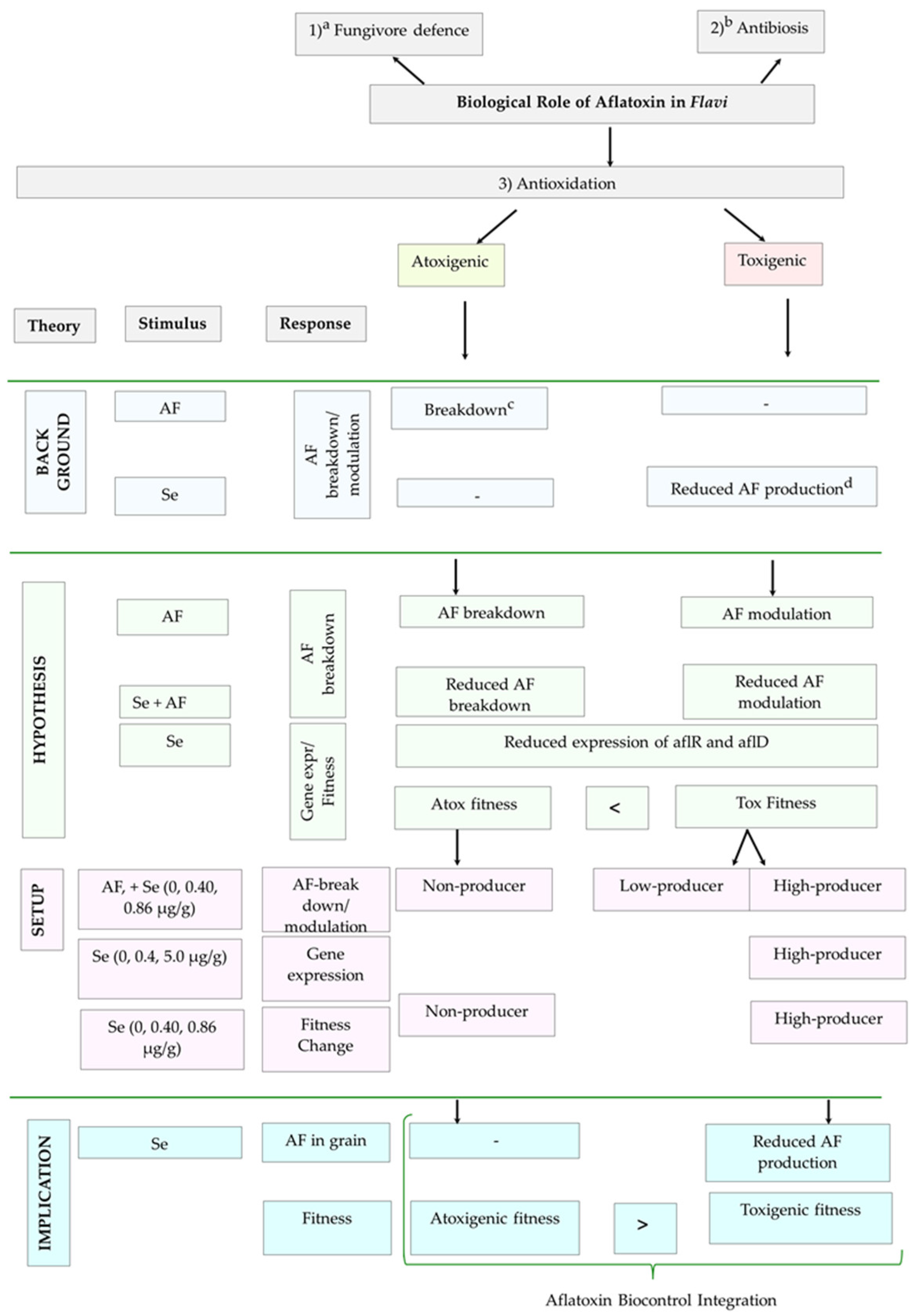
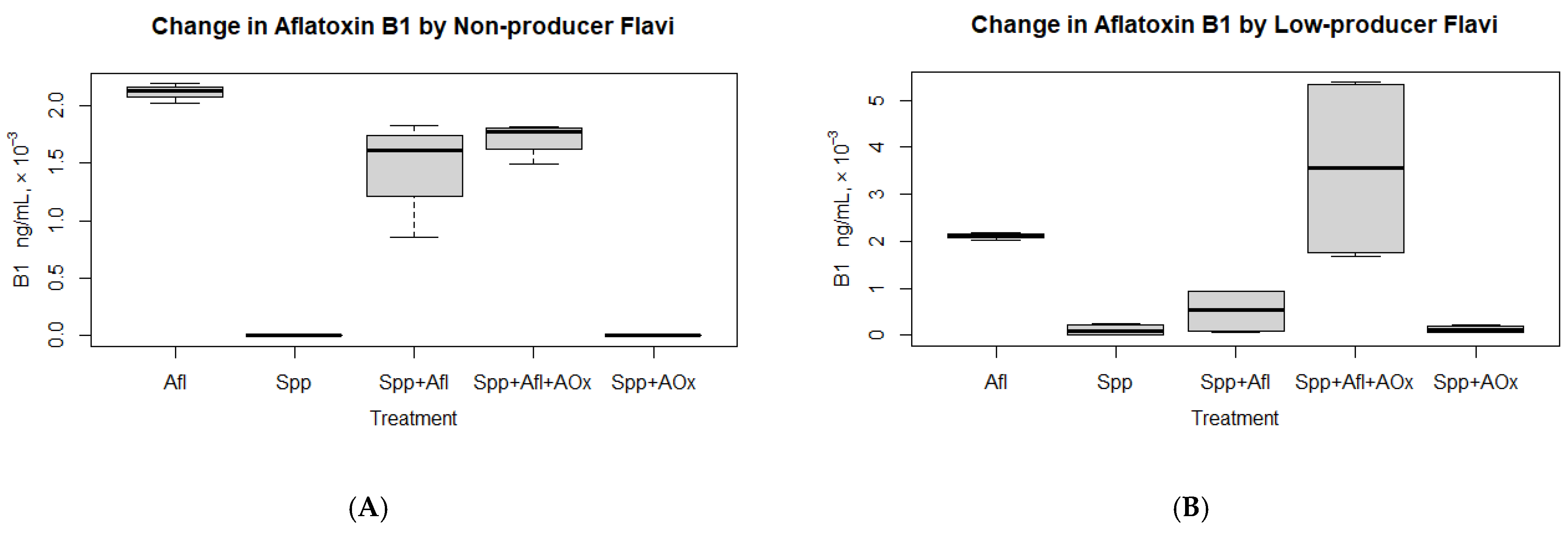
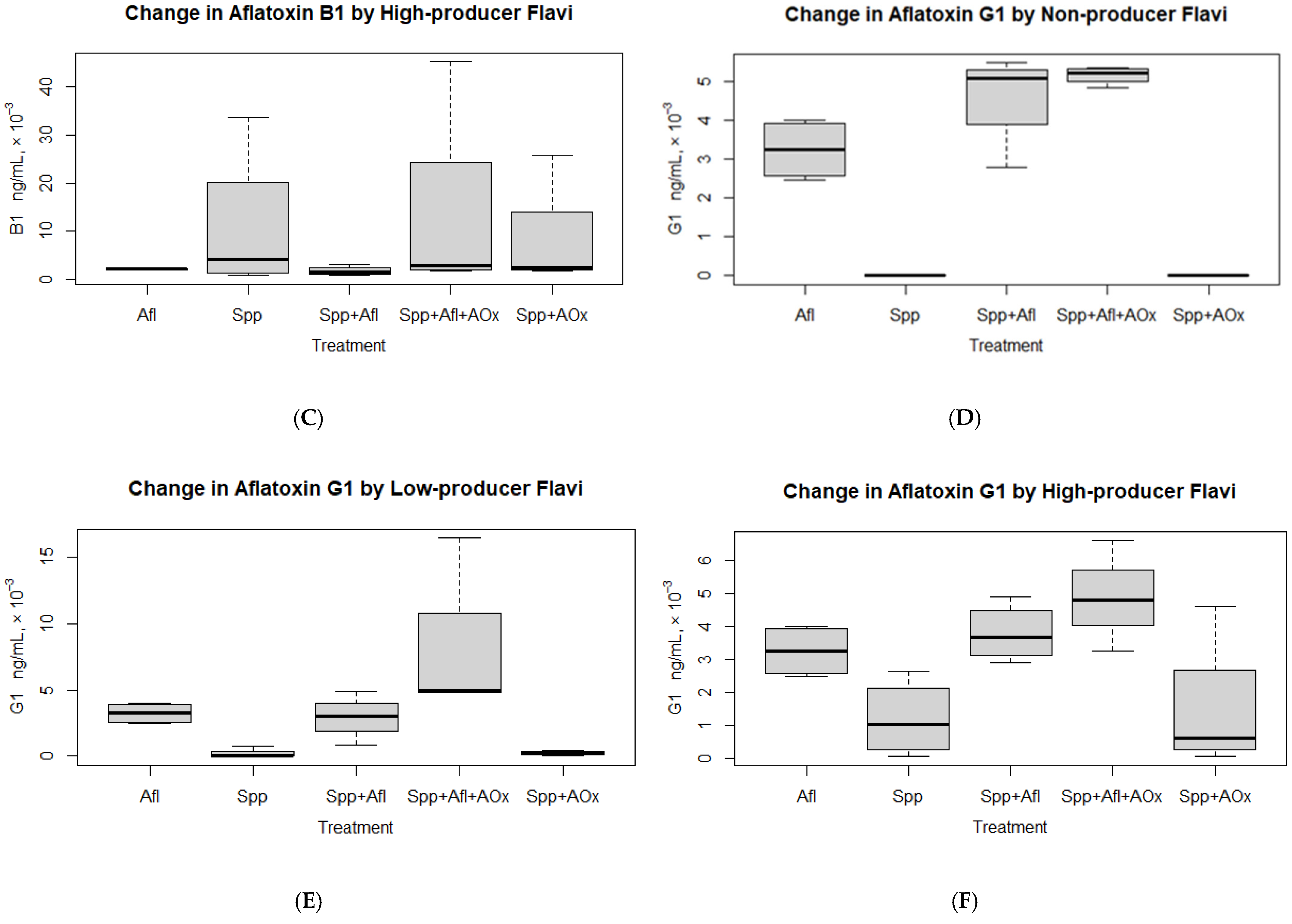
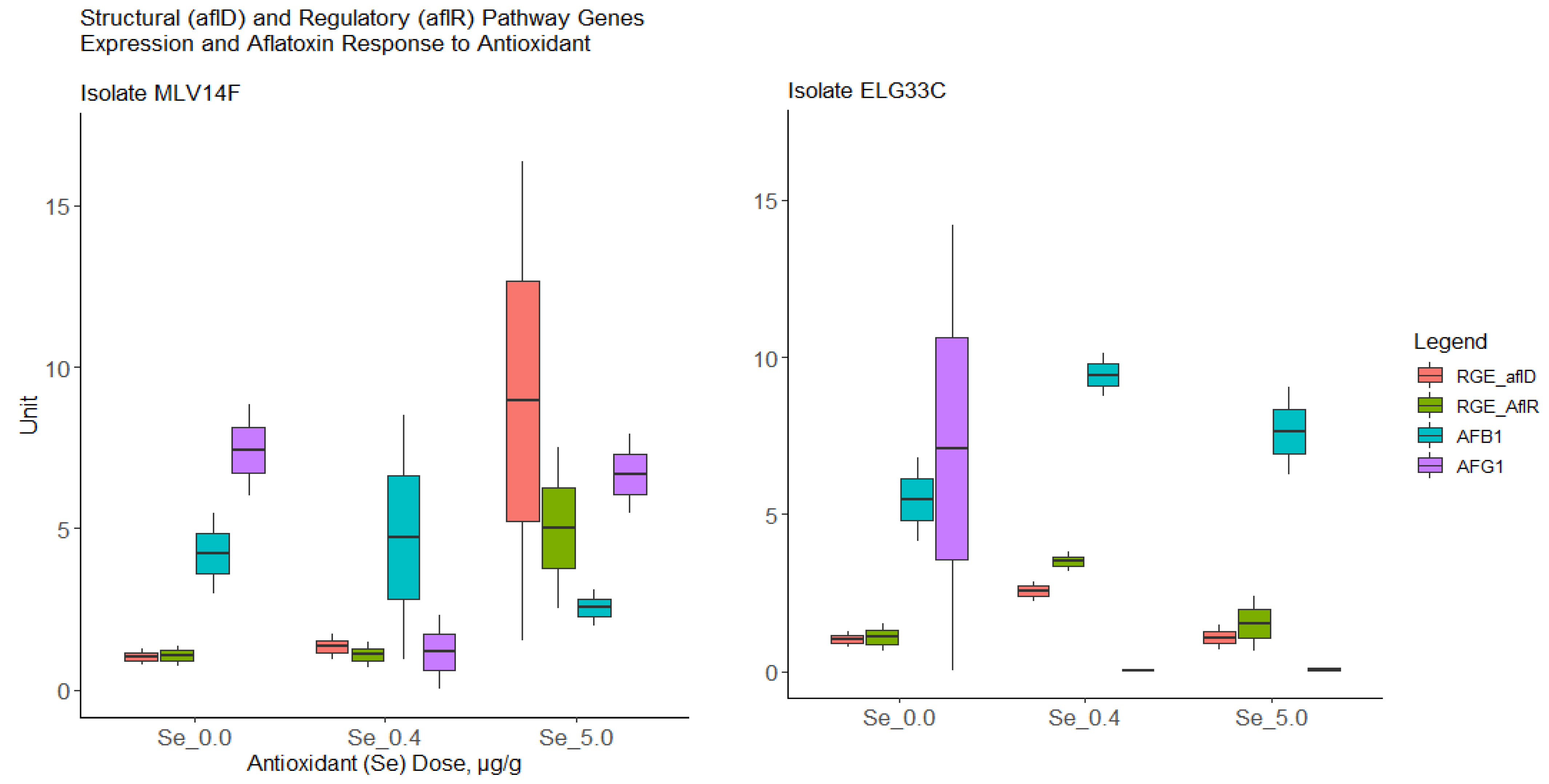
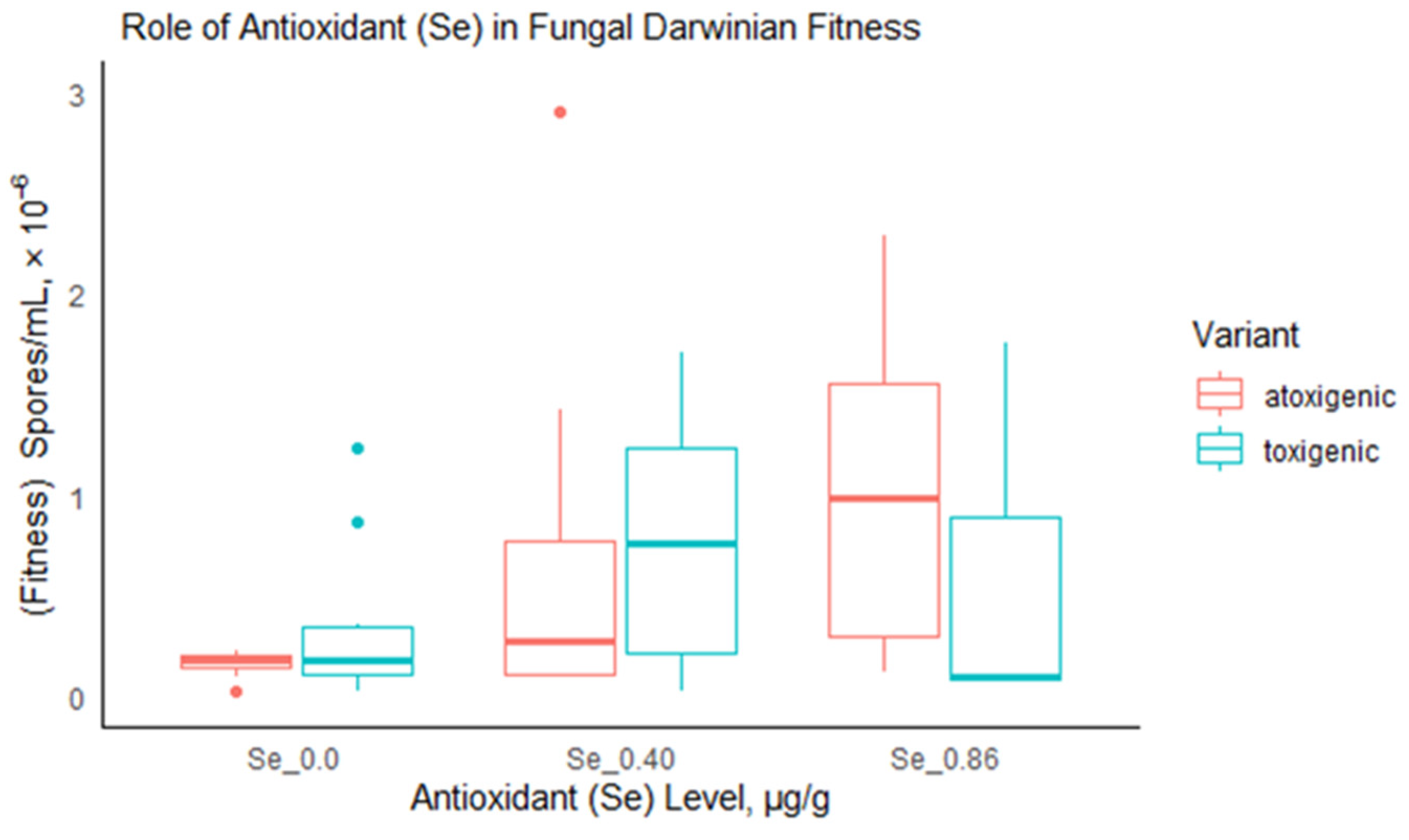
| Isolate | Aflatoxin-Production | Mean Aflatoxin Produced, ng/mL | |
|---|---|---|---|
| B1 | G1 | ||
| 1MS7 a | None | 0 | 0 |
| 125GF8 a | None | 0 | 0 |
| ESF24B | None | 0 | 0 |
| MLV12B | None | 0 | 0 |
| ESF62A b | Low | 0 | 0 |
| ELV13C | Low | 3.2 | 8.0 |
| MKZ06B | Low | 33.8 | 0 |
| EKZ10A | Low | 52.1 | 146.3 |
| MKA01K | High | 342.4 | 83.9 |
| EKW36B | High | 164.6 | 323.3 |
| EKW40A | High | 1340.2 | 527.6 |
| ELG33C | High | 6749.8 | 10.4 |
| Gene | Primer Name | Primer Pair Nucleotide Sequence | Position * | GenBank Accession No. | Reference |
|---|---|---|---|---|---|
| aflR | AflR taq1 | (F)—TCG TCC TTA TCG TTC TCA AGG | 1646 | AF441435.2 | [46] |
| AflR taq2 | (R)—ACT GTT GCT ACA GCT GCC ACT | 1735 | |||
| aflD | Nor taq1 | (F)—GTC CAA GCA ACA GGC CAA GT | 516 | XM_002379908.1 | [47] |
| Nor taq2 | (R)—TCG TGC ATG TTG GTG ATG GT | 562 | |||
| β-tubulin | Ben taq 1 | (F)—CTT GTT GAC CAG GTT GTC GAT | 65 | AF036803.1 | [46] |
| Ben taq 2 | (R)—GTC GCA GCC CTC AGC CT | 99 |
| Toxigenicity | AF Digestion: [A] “Afl” v “Spp+Afl” | [B] Effect on AF Max Levels If AF was Not Reduced in [A]: [“Spp” v “Spp+Afl”] | ||
|---|---|---|---|---|
| B1 | G1 | B1 | G1 | |
| None | Reduced, p = 0.029 | No reduction, p = 0.114 | Not applicable | Not applicable |
| Low | Reduced, p = 0.029 | No reduction, p ~ 0.99 | Not applicable | Not applicable |
| High | No reduction, p = 0.34 | No reduction, p = 0.34 | Max produced reduced (33,749 to 3169) | Max produced exceeded (2638 to 4914) |
| Aflatoxin-Production | AF Utilisation: [C] “Spp+Afl” v “Spp+Afl+AOx” | AF Suppression: [D] Effect on Se on Max Levels [“Spp” v “Spp+AOx”] | ||
|---|---|---|---|---|
| B1 | G1 | B1 | G1 | |
| None | Se no effect, B1 reduction same p = 0.69 | Se no effect, No G1 reduction same p = 0.69 | Not applicable | Not applicable |
| Low | B1 utilisation reduced by Se, p = 0.03 | G1 non-utilisation unaffected by Se, p = 0.11 | No effect, p = 0.89; B1 Max produced not exceeded (260 to 214) | No effect, p = 0.66; G1 Max produced not exceeded (732 to 463) |
| High | B1 utilisation not affected by Se, p = 0.11 | G1 non-utilisation unaffected by Se, p = 0.49 | No effect, p = 0.89; B1 Max produced not exceeded (33,749 to 25,842) | No effect, p ~ 0.99; G1 Max produced is exceeded (2638 to 4612) |
Disclaimer/Publisher’s Note: The statements, opinions and data contained in all publications are solely those of the individual author(s) and contributor(s) and not of MDPI and/or the editor(s). MDPI and/or the editor(s) disclaim responsibility for any injury to people or property resulting from any ideas, methods, instructions or products referred to in the content. |
© 2023 by the authors. Licensee MDPI, Basel, Switzerland. This article is an open access article distributed under the terms and conditions of the Creative Commons Attribution (CC BY) license (https://creativecommons.org/licenses/by/4.0/).
Share and Cite
Katati, B.; Kovacs, S.; Njapau, H.; Kachapulula, P.W.; Zwaan, B.J.; van Diepeningen, A.D.; Schoustra, S.E. Aflatoxigenic Aspergillus Modulates Aflatoxin-B1 Levels through an Antioxidative Mechanism. J. Fungi 2023, 9, 690. https://doi.org/10.3390/jof9060690
Katati B, Kovacs S, Njapau H, Kachapulula PW, Zwaan BJ, van Diepeningen AD, Schoustra SE. Aflatoxigenic Aspergillus Modulates Aflatoxin-B1 Levels through an Antioxidative Mechanism. Journal of Fungi. 2023; 9(6):690. https://doi.org/10.3390/jof9060690
Chicago/Turabian StyleKatati, Bwalya, Stan Kovacs, Henry Njapau, Paul W. Kachapulula, Bas J. Zwaan, Anne D. van Diepeningen, and Sijmen E. Schoustra. 2023. "Aflatoxigenic Aspergillus Modulates Aflatoxin-B1 Levels through an Antioxidative Mechanism" Journal of Fungi 9, no. 6: 690. https://doi.org/10.3390/jof9060690






